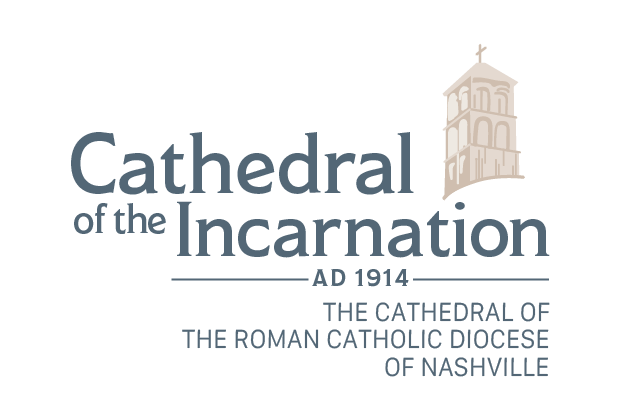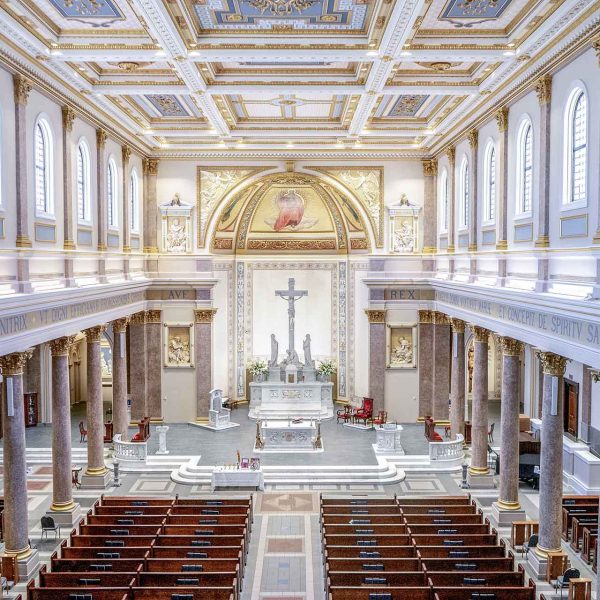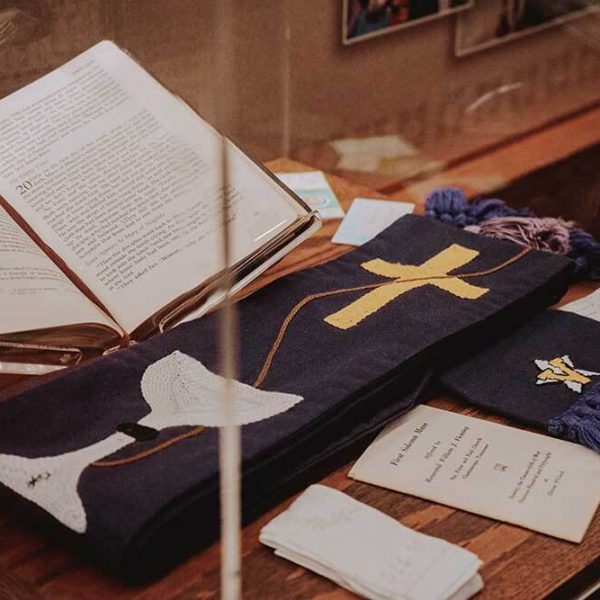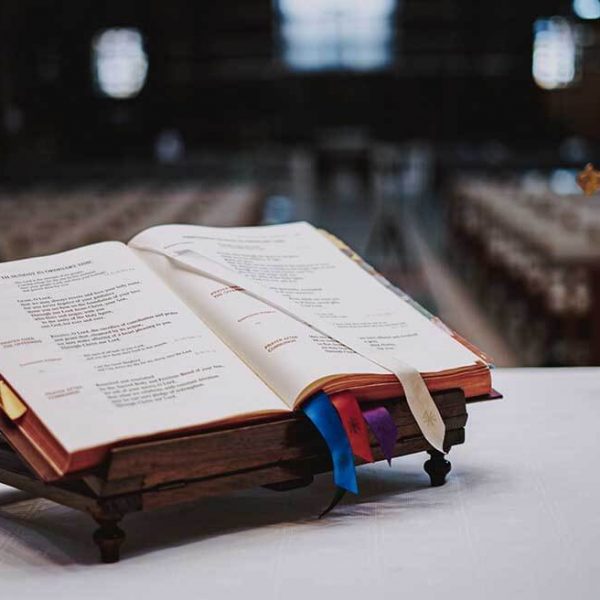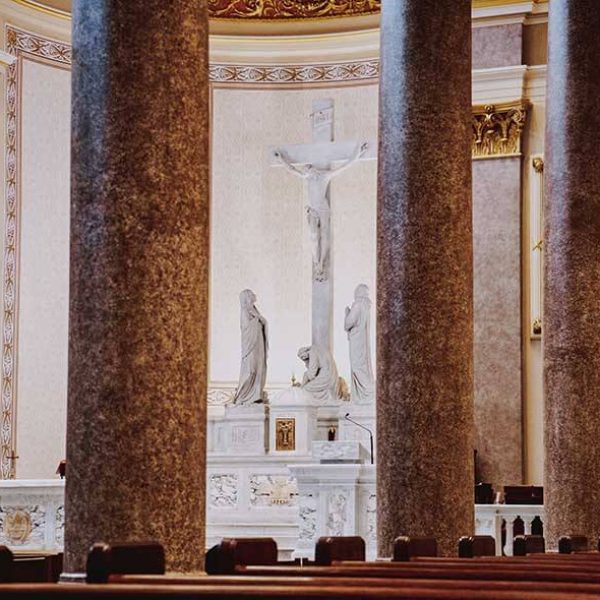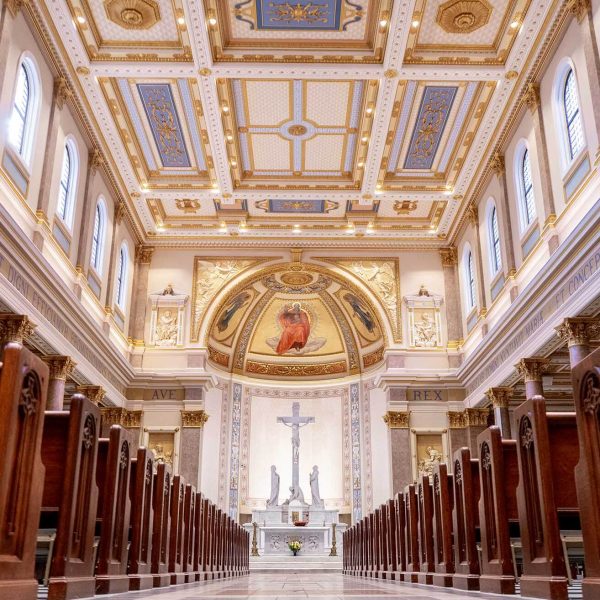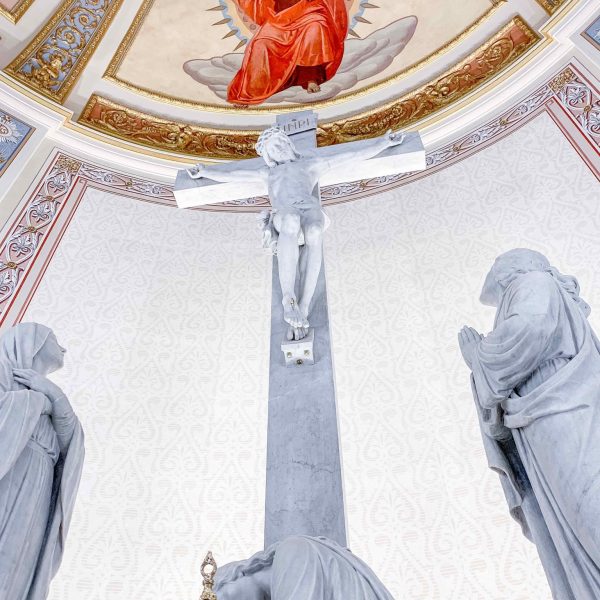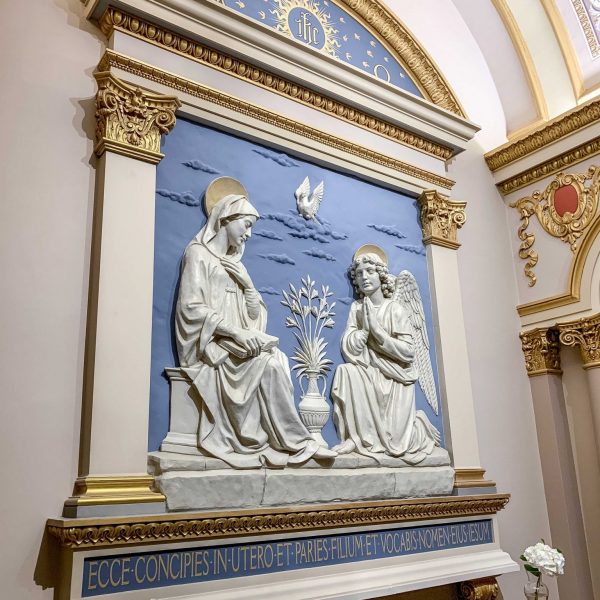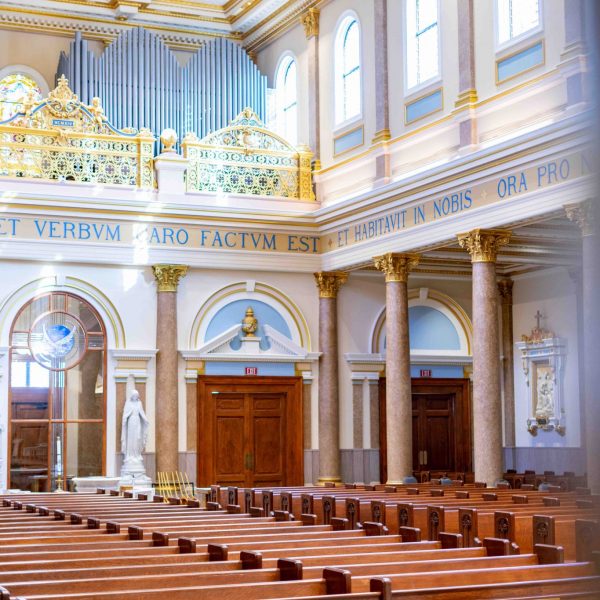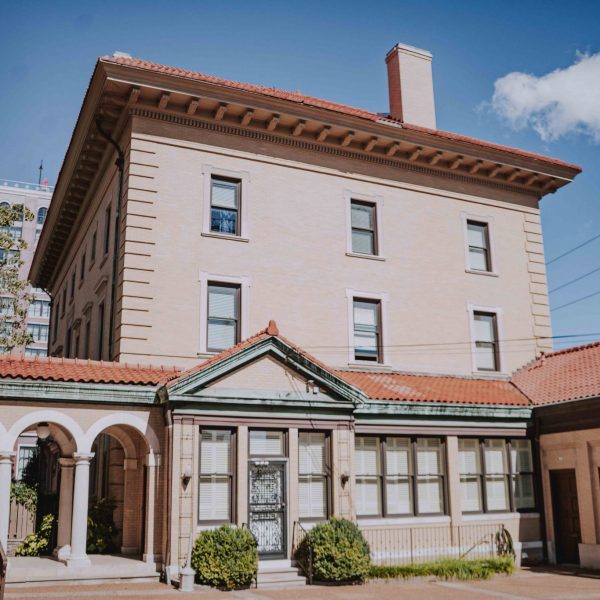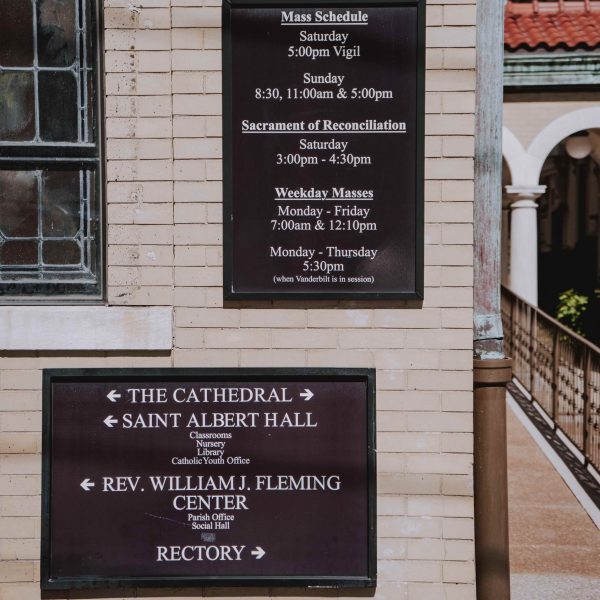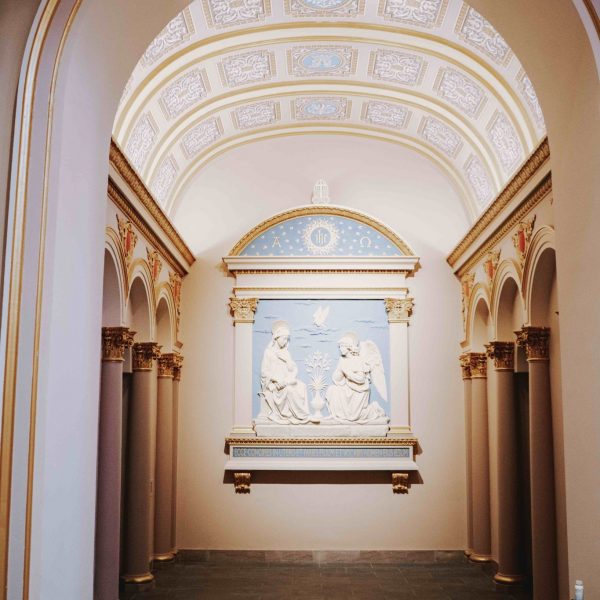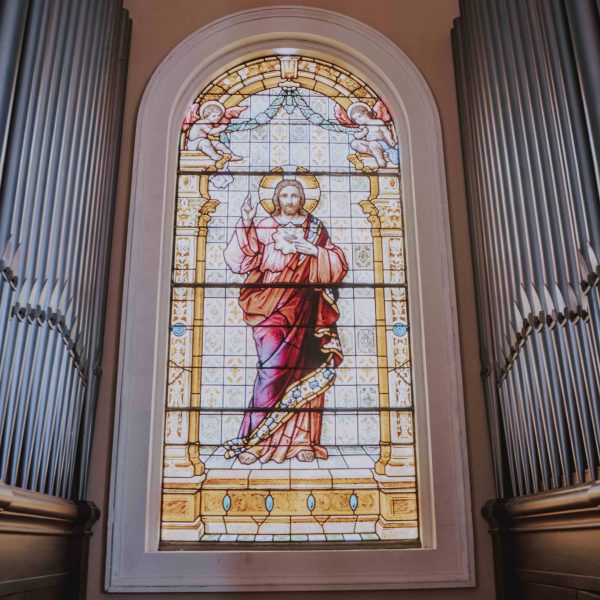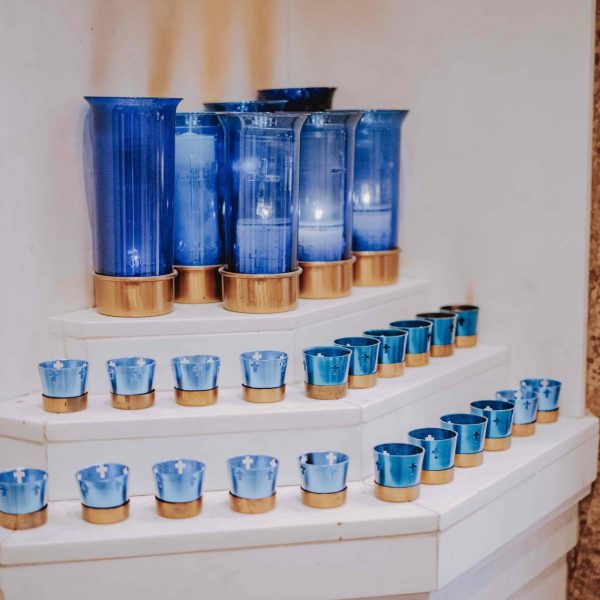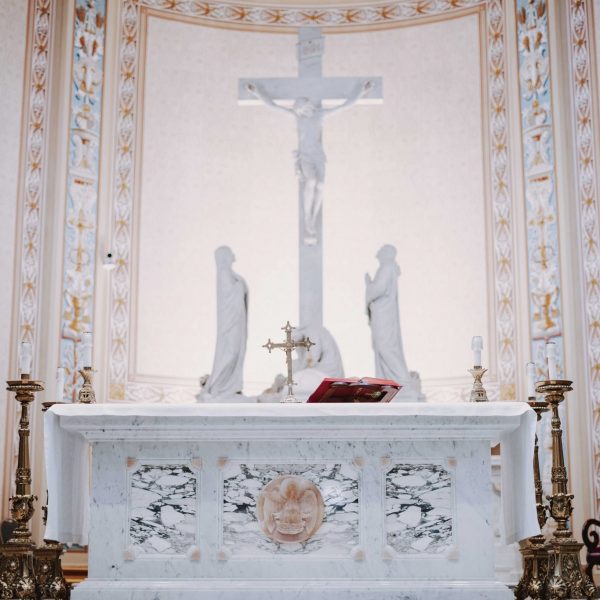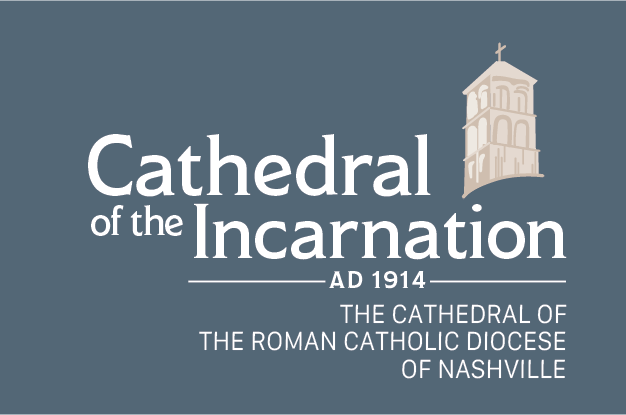The Cathedral of the Incarnation is both a sacred place for worship and a spectacular work of art. This tour of the Cathedral will highlight many of its main features; only closer reflection will reveal the richness in beauty and symbolism.
The basilica-style architecture of the building, with its yellow glazed brick and red tile roof, was modeled on one of the most famous churches in Rome, the church of San Martino ai Monti (St. Martin’s on the Hill). The interior of the Cathedral is decorated in Thirteenth Century Italian Renaissance style. The inside dimensions of the church proper are 175 by 96 feet. The Cathedral seats 1,000 people comfortably.
Rising 100 feet above the Cathedral is the campanile, or tower, which is a replica of one at the famous Roman church, St. Damase. The bell was recently renovated and rings each.
The building to the east of the Cathedral is the rectory, which is the residence of the former Bishops of Nashville and the current Cathedral priests. The rectory is fashioned after the Farnese Palace in Rome, one of the most beautiful dwelling places in the city. On the west side of the Cathedral is St. Albert Hall, which originally served as a parish school and temporary Cathedral while the main building was under construction, as well as during two major renovations. St. Albert Hall is now a multi-purpose building, used for religious education, special events, RCIA sessions, and wedding receptions.
There are three entrances to the Cathedral: the main entrance on West End Avenue, and two smaller entrances with ramps for the handicapped at both corners of the south end of the building.
VESTIBULE (NARTHEX)
From the main entrance off West End Avenue, you enter the vestibule. At the east end of the vestibule is the vesting sacristy, where the priest prepares to preside over Mass. The small door at the west end of the vestibule leads upstairs to the choir loft. The choir loft features a restored organ built by the Pilcher family in Louisville, Kentucky.
The vestibule not only protects the main Cathedral building from the weather, but also serves as an area where families with active children can attend Mass without disturbing others.
BAPTISTRY
The Baptistry at the north end of the nave includes a pool and a baptismal font, which also serves as a large holy water font. Catholics traditionally will place their fingers in the holy water, then make the Sign of the Cross to recall their entrance into the Church and the Christian faith through Baptism. The font pre-dates the Cathedral of the Incarnation by about 10 years and was originally a part of St. Mary’s of the Seven Sorrows when it was Nashville’s Cathedral. It is a scaled-down replica of the baptismal font designed by Michelangelo at St. Peter’s Basilica in Rome.
The octagon shape of the pool is a traditional symbol for the resurrection, which is sometimes called the Eighth Day of Creation.
Statues of the Holy Family stand on each side of the Baptistry. The large window that frames the Baptistry includes a cross and a dove – a symbol for the crucifixion and the Holy Spirit. The dove is made of opalescent glass. It is designed after the famous Holy Spirit window in St. Peter’s in Rome.
CEILING & ANGELUS
The main ceiling is a central feature of the Cathedral’s interior. It is believed to be the first of its kind in the United States, made of an ornamental plaster called Rigalico. A close look will reveal that the symbols in the north end of the nave are associated with the death of Jesus, while those of the south end nearest the sanctuary are more related to His birth as the Incarnation of God. Look for a pair of dice (used to cast lots for Jesus’ clothing) and the Greek letters Alpha and Omega (beginning and end). You will find a shepherd’s crook with a cross, a crown of thorns with three nails, and many others.
The clerestory windows were made of art glass by the Louisville Art Glass Company. They include blue Flashed Glass, handblown in France. There’s also some Drawn Antique Lead Crystal glass, a clear glass that forms a checkerboard effect. The other colors in the floral patterns were created using a glass paint. On a sunny day, prisms on the west windows cast rainbow effects throughout the Cathedral. The clerestory windows were designed to provide light and to focus one’s attention on the sanctuary at the south end of the building.
Beneath the clerestory windows circling the nave, is the Angelus, is translated as:
“The Angel of the Lord declared unto Mary, and she conceived of the Holy Spirit. Behold the handmaid of the Lord. Be it done unto me according to your word. And the Word was made flesh and dwelt amongst us. Pray for us, Holy Mother of God, that we may be made worthy of the promises of Christ.”
The words “AVE REX” (Hail King) flanking the dome of the apse are not a part of the Angelus. The Angelus is recited daily by some pious Catholics at 6:00 am, noon, and 6:00 pm.
The pews on either side of the aisle have been at the Cathedral since it was built in 1914. They were made in Jackson, Tennessee of white oak. The kneelers were replaced in 1984.
STATIONS OF THE CROSS
In most Catholic churches, you will find a depiction of the Via Dolorosa, or Way of the Cross, depicting 14 events leading from Jesus’s arrest to His crucifixion. These events are captured in the Stations of the Cross along the east and west walls. The Stations of the Cross in the Cathedral are made of scalioli, giving the appearance of old ivory. Devout Catholics visit each of these stations, especially during Lent, to pray and reflect on the messages that each one offers.
GOSPEL PICTURES
The four large rectangular sculptures that help frame the apse are depictions of the four evangelists: John and Matthew to the east side of the apse, and Mark and Luke to the west. These images are full of symbolism taken from the Old and New Testaments, particularly the books of Ezekiel and Revelation: the eagle, lion, ox, and face of a man. St. John is associated with the symbol of the eagle because of his lofty theological flights in the gospel. St. Matthew is associated with the face of man because in his gospel he firmly establishes the human nature of Jesus. St. Luke is the ox because his Gospel emphasizes the theme of sacrifice. St. Mark is associated with the symbol of the lion because he begins his Gospel with the ministry of John the Baptist – the voice crying out in the wilderness.
RECONCILIATION CHAPEL
The Reconciliation Chapel is located to the west of the sanctuary. This area provides a quiet place for prayer and meditation in preparation for celebrating the Sacrament of Reconciliation. This area is dominated by a large wooden crucifix, which was commissioned by the late Bishop Smith while visiting Oberammergau, in Bavaria, Germany, in 1930. Oberammergau is the site of a large Benedictine Monastery and also the site of the world famous Passion Play, held there every 10 years. Another special feature in the Reconciliation chapel is an art glass window that depicts the Blessed Virgin as a child with St. Anne.
NOTE: Confessions are heard each Wednesday and Saturday afternoons. Please do not enter the door of the confessional if it is closed.
PICTURE IN THE DOME
Looking above the white marble crucifixion scene, you’ll see paintings depicting God the Creator blessing the world. He is flanked by paintings of angels. These images were painted on canvas, then attached to the dome. While intrinsically beautiful, the paintings also help draw people’s attention to the sanctuary.
SANCTUARY & ALTAR
The sanctuary is the focal point of the Cathedral. This is where Mass is celebrated. There are three places of primary liturgy importance in the sanctuary: the altar; the area dominated by the cathedra (the chair of the Bishop of Nashville); and the ambo (or pulpit), from which the Word of God is proclaimed.
The altar is one of the most important symbols for the presence of Christ in a Roman Catholic Church. It represents Jesus as priest, inviting us to share the meal he offered to the Apostles at the Last Supper and Christ as the lamb of sacrifice, who was offered up for us on the Cross (an altar of sacrifice). The main altar at Cathedral was built during the 1987 renovation. The marble inlay on the front depicts the Lamb of the Seven Seals from Revelations 5 and 6.
The altar, as is customary in the Catholic Church, contains a relic from a saint, usually a martyr. The relic in the main altar is that of Pope Victor I, who was Bishop of Rome between 189 and 199 AD. St. Victor was not a martyr, but was persecuted for his zealous approach to spreading of the gospel.
The name “Cathedral” comes from the Greek “cathedra,” which means “chair.” The cathedra is the bishop’s chair, and the Cathedral is where the bishop’s chair is located. You will notice the cathedra at the top of the steps in the rear of the sanctuary. It includes a coat of arms on the top of the backrest. Each Bishop has his own coat-of-arms.
Behind the Bishop’s chair, there is a large marble crucifixion scene. This was sculpted in Italy and put into place during the 1937 renovation. Visitors are welcome to come forward (outside of ceremonies) to examine the incredible detail of the crucifixion scene and the Bishop’s coat-of-arms.
BLESSED SACRAMENT CHAPEL
The Blessed Sacrament Chapel was created during the most recent renovation in 1987. This chapel is intended to promote private Eucharistic devotion. It is located to the area east of the sanctuary. This chapel houses the tabernacle which holds the Blessed Sacrament.
Prior to entering this chapel, look above and see the sanctuary lamp hanging from the ceiling. This lamp has been hanging in the Cathedral since 1914. When lit, the lamp serves as a signal that the Blessed Sacrament is present in the tabernacle. It is appropriate to genuflect or bow when entering or leaving the church when the lamp is lit.
Bishops in Residence at the Cathedral of the Incarnation
DATES INDICATE TERM AS BISHOP:
- Thomas Sebastian Byrne, 1894-1923
- Alphonse J. Smith, 1924-1935
- James D. Niedergeses, 1975-1992
- Edward U. Kmiec, 1992-2004
- David R. Choby, 2006-2017
- Mark Spalding, 2018-present
Note: Bishops William L. Adrian (1936-1969) and Joseph A. Durick (1969-1975) did not live in residence at the Cathedral rectory.
